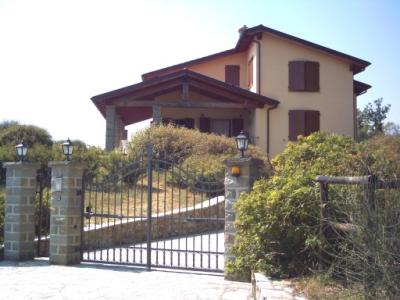
7 more images below...
|
Villa Clara - Castel Di Casio
Villa For sale in Castel Di Casio, Bologna, Italy - Via Pieve Spondaccia n. 5
|
Sale Price: EUR950,000.00 - EUR950,000.00 (Negotiable)
|
|
|
Villa Clara in Castel Di Casio is located in a panoramic place. One of the most beautiful areas of the tosco-emiliane hills. Overlooking the Valle del Reno that connects Tuscany and Emilia-Romagna (equidistant and close to Florence and Bologna in Italy).
This 400 sq.m. villa, developed on three floors, consists of:
- Four bedrooms
- Two bathrooms
- Two large living rooms
- Kitchen finished in stonework
- Closet
- Large garage
- Boiler room and gpl tank
- Veranda
- Central heating system
- Alarm system
- Voice and network (adsl) system
- Tv
The villa, built on 2002, is constructed and finished by quality materials .
The park, about 4,000 sq.m. includes over 3,000 plants.
An automatic irrigation system is available.
The property is completed by a large ground (about 22,000 sq.m.) not close to the villa.
-----------------------------------
Additional info on Castel Di Casio:
-----------------------------------
Castel Di Casio is in the high Bolognese, Pratese and Pistoiese Apennine: an ancient land, rich of tradition and history, a fascinating place that offers reasons of interest and curiosity. A mountain oasis between Emilia and Tuscany.
The upper valley of the eastern Limentra runs from its source in the peaks of the Apennine mountains to the artificially formed Lake Suviana. That is from Tuscany grand duchy to the border of the Papal State of Emilia - Romagna. Its earliest human explorers were probably travellers between the two provinces; they would most likely have used the route along the western crest of the valley side. Later, along this route, was established the important abbey at Fontana Taona. As the value of the resources of the valley became known to the great cities of the plains, however, small manufacturing villages, which were able to develop those resources, grew up along the bottom of the valley and, gradually, the track which joined them supplanted the earlier route along the crest. The resources of the valley may be categorized as: stone, trees, water and people; and the city institutions which benefited from them as the military and the church.
The valley of the Western Limentra is in many ways a typical example of an Apennine mountain valley. It is still possible to see that, until relatively recently, there existed here, as in many other of these mountains valleys, an extensive network of forest tracks which joined together not only village communities but also the agricultural, social and cultural systems which gave them life. Where this valley differs from many of its neighbors, and what gives it, therefore, a substantial part of its distinctive character, is that for at least a thousand years that system has interacted with and been overlaid by an important national route. The national route brought into the hearth of the tight-knit valley community a constant flow of travellers from the outside world. It witnessed major transapennine journeys of pilgrimage in the medieval period, journeys of commerce and expansion in the age of enlightenment, and journeys displaying unprecedented military might in more recent times. But it also witnessed, far more, frequently of course, the humble journeys of common people passing through the valley.
|

